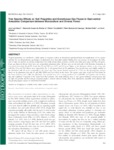Use este identificador para citar ou linkar para este item:
http://www.alice.cnptia.embrapa.br/alice/handle/doc/976693Registro completo de metadados
| Campo DC | Valor | Idioma |
|---|---|---|
| dc.contributor.author | VAN HAREN, J. | pt_BR |
| dc.contributor.author | OLIVEIRA JUNIOR, R. C. de | pt_BR |
| dc.contributor.author | BELDINI, P. T. | pt_BR |
| dc.contributor.author | CAMARGO, P. B. | pt_BR |
| dc.contributor.author | KELLER, M. | pt_BR |
| dc.contributor.author | SALESKA, S. | pt_BR |
| dc.date.accessioned | 2014-01-20T11:11:11Z | pt_BR |
| dc.date.available | 2014-01-20T11:11:11Z | pt_BR |
| dc.date.created | 2014-01-20 | pt_BR |
| dc.date.issued | 2013 | pt_BR |
| dc.identifier.citation | Biotropica, v. 45, n. 6, p. 709-718, 2013. | pt_BR |
| dc.identifier.uri | http://www.alice.cnptia.embrapa.br/alice/handle/doc/976693 | pt_BR |
| dc.description | Tropical plantations are considered a viable option to sequester carbon on abandoned agricultural lands, but implications of tree species selection for overall greenhouse gas budgets on plantations have been little studied. During three wet seasons, we investigated the influence of nine tree species on soil pH, temperature (ST), bulk density (BD), moisture content water filled pore space (WFPS), and greenhouse gas fluxes in diverse forest sites and monoculture plantation plots. All sites were on clay-rich soils of the Barreiras formation, in east-central Amazônia, Brazil. We found that ST and BD were 0.6°C and 0.2 g/cm3 higher in the plantation relative to the forest, and soil CH4, CO,2 and N2O fluxes were, respectively, 38, 12, 62, percent lower in the plantation. Tree growth rates were highly variable on the plantation, with the mean comparable to the forest sites. Tree species identity mattered (P < 0.01) for all soil properties and gas fluxes on the plantation, but only for pH, BD, WFPS, and N2O fluxes in the forest. The species rank order of pH and N2O fluxes in the forest, however, were unlike the plantation. Tree growth rates were a strong predictor for soil WFPS, and together with location, they also explained 75 percent of the mean N2O flux variation. Our study indicates that: (1) tree species influence soil processes; and (2) high tree growth and low soil gas emissions imply a reduced climate forcing effect from plantations, especially when planted with fast-growing legume species on abandoned farmland. | pt_BR |
| dc.language.iso | eng | eng |
| dc.rights | openAccess | eng |
| dc.subject | Plantation | pt_BR |
| dc.subject | Tropical | pt_BR |
| dc.title | Tree species effects on soil properties and greenhouse gas fluxes in East-central Amazonia: comparison between Monoculture and Diverse Forest. | pt_BR |
| dc.type | Artigo de periódico | pt_BR |
| dc.date.updated | 2014-12-16T11:11:11Z | pt_BR |
| dc.subject.nalthesaurus | Carbon dioxide | pt_BR |
| dc.subject.nalthesaurus | Methane | pt_BR |
| dc.subject.nalthesaurus | Nitrous oxide | pt_BR |
| dc.subject.nalthesaurus | Tree growth | pt_BR |
| dc.description.notes | Artigo publicado por Pesquisador Visitante da Embrapa Monitoramento por Satélite. | pt_BR |
| riaa.ainfo.id | 976693 | pt_BR |
| riaa.ainfo.lastupdate | 2014-12-16 | pt_BR |
| dc.identifier.doi | 10.1111/btp.12061 | pt_BR |
| dc.contributor.institution | JOOST VAN HAREN, UNIVERSITY OF ARIZONA; RAIMUNDO COSME DE OLIVEIRA JUNIOR, CPATU; PATRICK TROY BELDINI, UNIVERSIDADE FEDERAL DO OESTE DO PARÁ; PLINIO BARBOSA DE CAMARGO, CENA/USP; MICHAEL KELLER, PESQUISADOR VISITANTE CNPM; SCOTT SALESKA, UNIVERSITY OF ARIZONA. | pt_BR |
| Aparece nas coleções: | Artigo em periódico indexado (CNPM)  | |
Arquivos associados a este item:
| Arquivo | Descrição | Tamanho | Formato | |
|---|---|---|---|---|
| vanHarenetalBiotropica2013nitrousoxideforestplantations.pdf | 279.34 kB | Adobe PDF |  Visualizar/Abrir |









